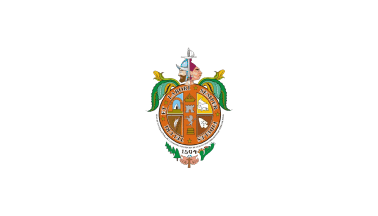
by Daniel Rentería, 22 April 2025
Photos: 1 from Municipal Institute of Culture

Last modified: 2025-05-02 by daniel rentería
Keywords: pinos | zacatecas | bandera municipal y escudo municipal (zacatecas) | escudo del municipio (zacatecas) | bandera del municipio (zacatecas) | héraldica municipal de zacatecas |
Links: FOTW homepage |
search |
disclaimer and copyright |
write us |
mirrors

by Daniel Rentería, 22 April 2025
Photos: 1 from
Municipal Institute of Culture
See also:
There is a flag which is white with the municipal coat of arms that exists in the Municipal Institute of Culture building.
Daniel Rentería, 22 April 2025
.gif)
image from Wikimedia Commons
The coat of arms of Pinos was adopted during the administration of Municipal President José Luis García Hernández (2004-2007), being approved by the council on 28 June 2005. Its author is the plastic artist Aurelio Pantaleón González Arenas, originally from Mexico City and in that time living in Ojuelas de Jalisco. As Director of the Municipal Culture Institute, Gabriel Edmundo Torres Muñoz promoted the creation of a municipal coat of arms, and Aurelio was asked to design it, with the motive of the 407th anniversary of Pinos.
Under a circle, the name "REAL DE NUESTRA SEÑORA DE LA PURISIMA CONCEPCION DE CUZCO Y DESCUBRIMIENTO DE SIERRA DE PINOS" goes around it, the original name of the population [Royal Town of Our Lady of the Immaculate Conception of Cuzco and Discovery of the Pine Tree Mountains]. Under this is the year 1594, its foundation; pine trees to the left recognizing its name (Pinos), to the right a cactus bearing fruit for its environment, and below two hands open bearing a cross for the evangelization. At the top to the sides, beans in a pod, leaves, and corn remembering the fruits of the land.
At the very top, a Spaniard and Indian head, divided by a sword, remembering the conquest of the land. Inside but around the circle are the words "SEMPER FIDELIS TELURI ET LABORI" [Always Faithful to Earth and Work], each word divided by a star. To the upper-left, an image of the entrance to the town. To the upper-right, a head of cattle and its child for the cattle-raising industry. To the lower-left, an image of a man climbing the ladder of Divine Ascent. To the lower-right, an image of an arrowhead and a petroglyph over it signifying the Indian past. In the middle but not in any section, a crown, fort, lion, and gold are symbols of the Spaniards that colonized the region.
Daniel Rentería, 22 April 2025
Anything below this line was not added by the editor of this page.